The Role of Fiber-Type Reinforcement in the Torsional Behavior of Solid and Hollow Reinforced Concrete Beams
Abstract
:1. Introduction
2. Materials and Experimental Work
2.1. Material Properties
2.2. Tested Beam Specimens
2.3. Test Procedure
3. Results and Discussion
3.1. Properties of Hardened Concrete
3.2. Modes of Failure and Torsional Capacity
3.3. Torsional Ductility Index
4. Conclusions
- The compressive strength, splitting tensile strength, and modulus of rapture of fiber-reinforced concrete were higher than those of plain concrete, where the increasing ratio reached approximately 25%, 94%, and 114%, respectively.
- Among the adopted types of fiber, corrugated steel fiber was the most effective at improving the mechanical properties of concrete, followed by hooked-end steel fiber, straight steel fiber, and polyolefin fiber.
- All of the tested beams failed via the same mode of failure, through the development of some major cracks from the bottom face upward, to the top face of the specimens, which increased in length and width with the increase in the applied torque until failure, without any significant effect of the fiber type.
- The effect of fiber shape on the torsional behavior of the tested beam specimens showed that the corrugated steel fiber produced the highest improvement, whereas the cracking torque was increased to approximately 50% and 132% for solid and hollow tested beams, respectively. However, the use of polyolefin fiber provided the better improvement in the torsional ductility of the tested beams, compared with the other types of fiber.
- Generally, it is preferable to use corrugated and hooked-end steel fibers to improve the torsional behavior of concrete because the bond between the concrete matrix is efficiently increased.
Author Contributions
Funding
Conflicts of Interest
References
- Guidance for the Design of Steel Fiber Reinforced Concrete; Technical Report, TR63; The Concrete Society: Camberley Surrey, UK, 2007.
- Yin, S.; Tuladhar, R.; Shanks, R.A.; Collister, T.; Combe, M.; Jacob, M.; Tian, M.; Sivakugan, N. Fiber preparation and mechanical properties of recycled polypropylene for reinforcing concrete. J. Appl. Polym. Sci. 2015, 132, 41866. [Google Scholar] [CrossRef]
- Zamanzadeh, Z.; Lourenço, L.; Barros, J. Recycled steel fiber reinforced concrete failing in bending and in shear. Constr. Build. Mater. 2015, 85, 195–207. [Google Scholar] [CrossRef]
- Wafa, F.F.; Ashour, S.A. Mechanical properties of high-strength fiber reinforced concrete. ACI Mater. J. 1992, 89, 449–454. [Google Scholar]
- Song, P.S.; Hwang, S. Mechanical properties of high-strength steel fiber-reinforced concrete. Constr. Build. Mater. 2004, 18, 669–673. [Google Scholar] [CrossRef]
- Thomas, J.; Ramaswamy, A. Mechanical properties of steel fiber-reinforced concrete. J. Mater. Civ. Eng. 2007, 19, 385–392. [Google Scholar] [CrossRef]
- Sahmaran, M.; Yaman, I.O. Hybrid fiber reinforced self-compacting concrete with a high-volume coarse fly ash. Constr. Build. Mater. 2007, 21, 150–156. [Google Scholar] [CrossRef]
- Abbass Khan, W.M.I.; Mourad, S. Evaluation of mechanical properties of steel fiber reinforced concrete with different strengths of concrete. Constr. Build. Mater. 2018, 168, 556–569. [Google Scholar] [CrossRef]
- Li, B.; Xu, L.; Shi, Y.; Chi, Y.; Liu, Q.; Li, C. Effects of fiber type, volume fraction and aspect ratio on the flexural and acoustic emission behaviors of steel fiber reinforced concrete. Constr. Build. Mater. 2018, 181, 474–486. [Google Scholar] [CrossRef]
- Marcos, G.; Alberti, A.E.; Jaime, C.G. Polyolefin Fibers for the Reinforcement of Concrete. In Alkenes; Book Chapter 6; InTech Open: London, UK, 2017. [Google Scholar]
- Balendran, R.V.; Zhou, F.P.; Nadeem, A.; Leung, A.Y.T. Influence of steel fibers on strength and ductility of normal and lightweight high strength concrete. Build. Environ. 2002, 37, 1361–1367. [Google Scholar] [CrossRef]
- Pająk, M.; Ponikiewski, T. Flexural behavior of self-compacting concrete reinforced with different types of steel fibers. Constr. Build. Mater. 2013, 47, 397–408. [Google Scholar] [CrossRef]
- Yoo, D.-Y.; Banthia, N.J.; Yang, M.; Yoon, Y.-S. Size effect in normal- and high-strength amorphous metallic and steel fiber reinforced concrete beams. Constr. Build. Mater. 2016, 121, 676–685. [Google Scholar] [CrossRef]
- Venkateshwaran, A.; Tan, K.H.; Li, Y. Residual flexural strengths of steel fiber reinforced concrete with multiple hooked-end fibers. Struct. Concr. 2017, 19, 352–365. [Google Scholar] [CrossRef]
- Yoo, D.-Y.; Yoon, Y.-S.; Banthia, N. Predicting the post-cracking behavior of normal- and high-strength steel-fiber-reinforced concrete beams. Constr. Build. Mater. 2015, 93, 477–485. [Google Scholar] [CrossRef]
- Altun, F.; Haktanir, T.; Ari, K. Experimental investigation of steel fiber reinforced concrete box beams under bending. Mater. Struct. 2006, 39, 491–499. [Google Scholar] [CrossRef]
- Namiq, Z.F. Design of Beam as a Hollow Cross Section By Using Steel Fiber Under Pure Torsion. Ph.D. Thesis, University of Salahaddin, Erbil, Iraq, 2012. [Google Scholar]
- Kandekar, S.B.; Talikoti, R.S. Study of torsional behavior of reinforced concrete beams strengthened with aramid fiber strips. Int. J. Adv. Struct. Eng. 2018, 10, 465–474. [Google Scholar] [CrossRef]
- Al-Attar, T.S.; Qader, S.S.; Hussain, A.H. Torsional Behavior of Solid and Hollow Core Self Compacting Concrete Beams Reinforced with Steel Fibers. Eng. Technol. J. 2019, 37, 248–255. [Google Scholar] [CrossRef]
- Giridhar, B.B.; Kumar, S. Experimental study on torsional shear behavior of high-strength steel fiber reinforced concrete with varying volume fraction. Int. J. Constr. Res. Civ. Eng. 2019, 5, 17–23. [Google Scholar]
- Zhang, L.; Zhao, J.; Fan, C.; Wang, Z. Effect of Surface Shape and Content of Steel Fiber on Mechanical Properties of Concrete. Adv. Civ. Eng. 2020, 2020, 8834507. [Google Scholar] [CrossRef]
- Mures, J.K.; Ahmed, M.A.; Chkheiwer, A.H. Torsional Behavior of High Strength Concrete Members Strengthened by Mixed Steel Fibers. J. Eng. 2021, 2021, 5539623. [Google Scholar] [CrossRef]
- ASTM C150/C150M-18; Standard Specification for Portland Cement. ASTM International: West Conshohocken, PA, USA, 2018.
- ASTM 114-18; Standard Test Methods for Chemical Analysis of Hydraulic Cement. ASTM International: West Conshohocken, PA, USA, 2018.
- ASTM C150/C150M-18; Standard Specification for Concrete Aggregates. ASTM International: West Conshohocken, PA, USA, 2018.
- Ding, L.; He, W.; Wang, X.; Cheng, F.; Wu, Z. Flexural behavior of reinforced concrete slabs strengthened with BFRP grids and PCM. J. Cent. South Univ. 2020, 51, 1085–1096. [Google Scholar]
- Patil, S.P.; Sangle, K.K. Tests of steel fiber reinforced concrete beams under predominant torsion. J. Build. Eng. 2016, 6, 157–162. [Google Scholar] [CrossRef]
- Amin, A.; Bentz, E.C. Strength of steel fiber reinforced concrete beams in pure torsion. Struct. Concr. 2018, 19, 684–694. [Google Scholar] [CrossRef]
- Zhou, J.; Shen, W.; Wang, S. Experimental study on torsional behavior of FRC and ECC beams reinforced with GFRP bars. Constr. Build. Mater. 2017, 152, 74–81. [Google Scholar] [CrossRef]
- Lau, C.K.; Htut, T.N.S.; Melling, J.J.; Chegenizadeh, A.; Ng, T.S. Torsional behavior of steel fiber reinforced alkali activated concrete. Materials 2020, 13, 3423. [Google Scholar] [CrossRef] [PubMed]
- Hussain, H.K.; Abbas, A.M.; Ojaimi, M.F. Fiber-Type Influence on the Flexural Behavior of RC Two-Way Slabs with an Opening. Buildings 2022, 12, 279. [Google Scholar] [CrossRef]
- Joh, C.; Kwahk, I.; Lee, J.; Yang, I.; Kim, B.S. Torsional behavior of high strength concrete beams with minimum reinforcement ratio. Adv. Civ. Eng. 2019, 2019, 1432697. [Google Scholar] [CrossRef]
- Facconi, L.; Minelli, F.; Ceresa, P.; Plizzari, G. Steel fibers for replacing minimum reinforcement in beams under torsion. Mater. Struct. 2021, 54, 34. [Google Scholar] [CrossRef]
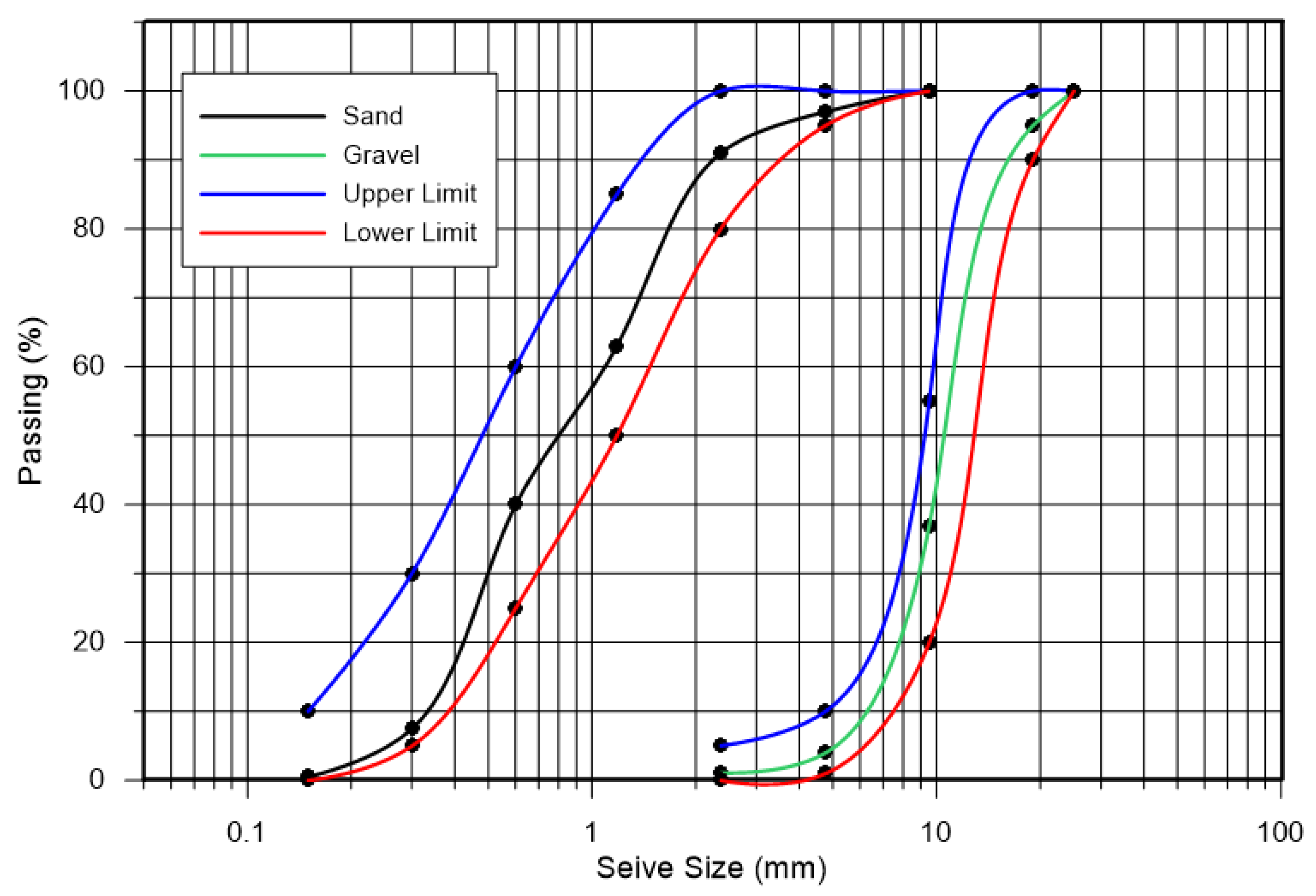
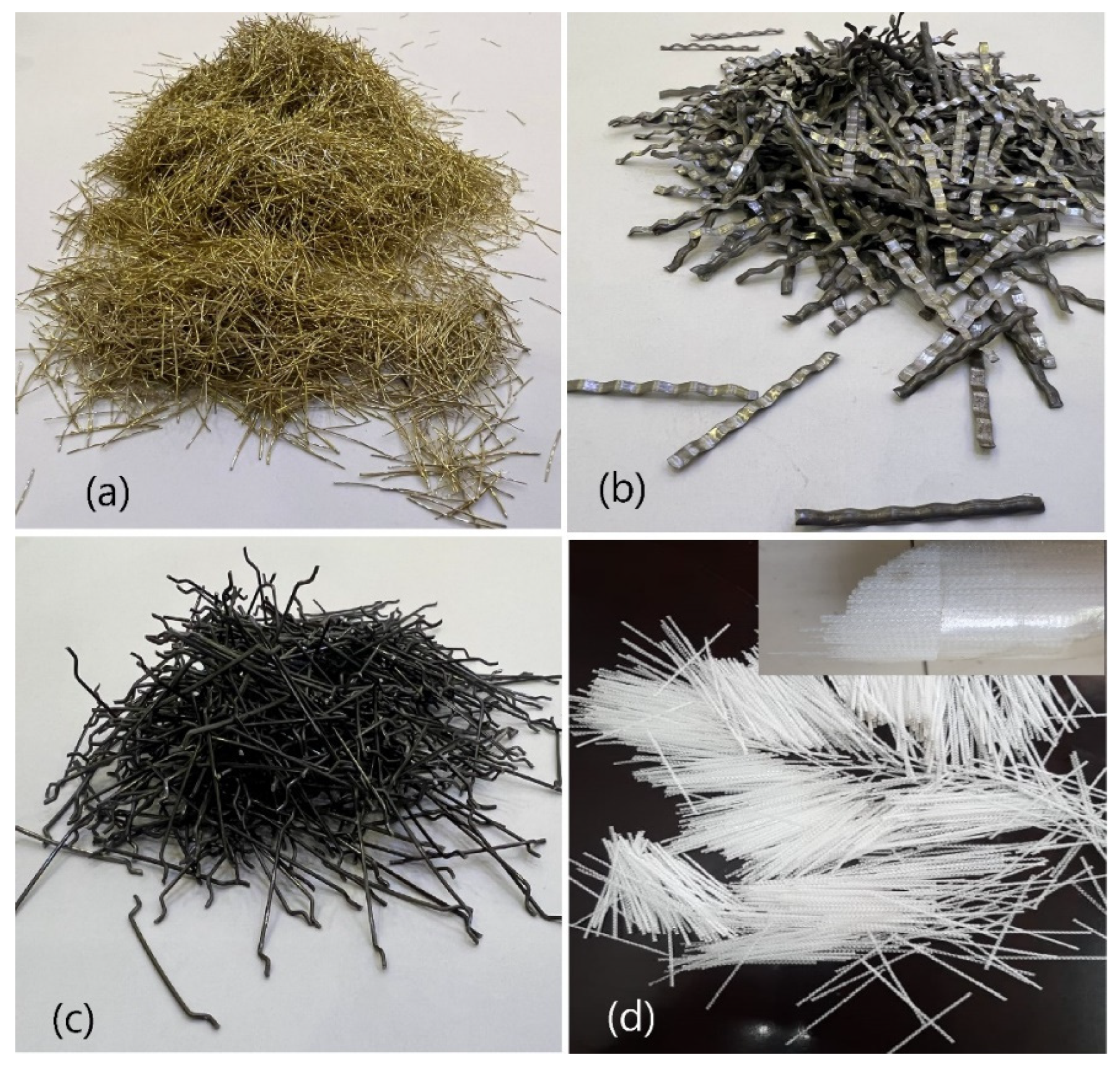
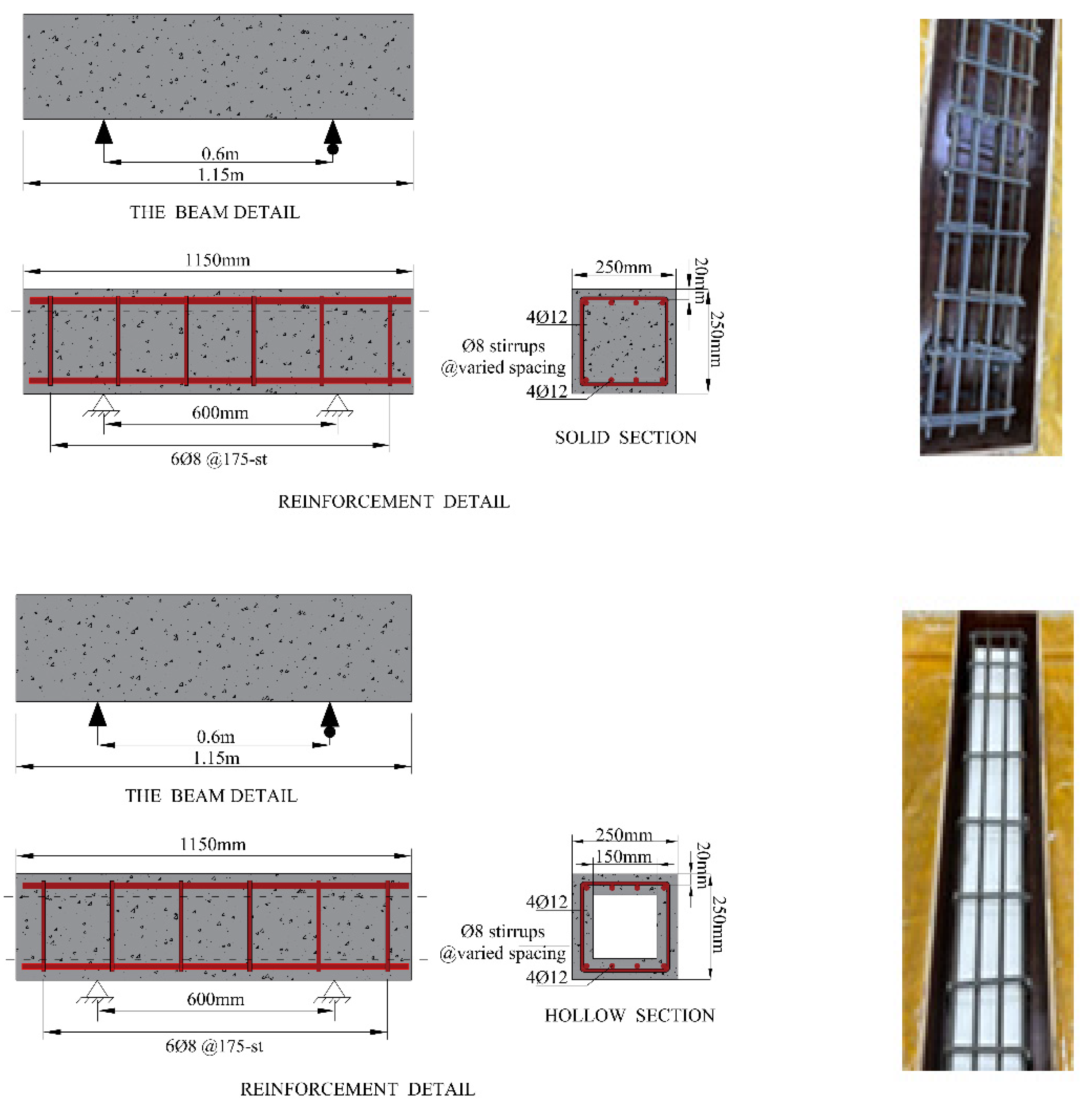
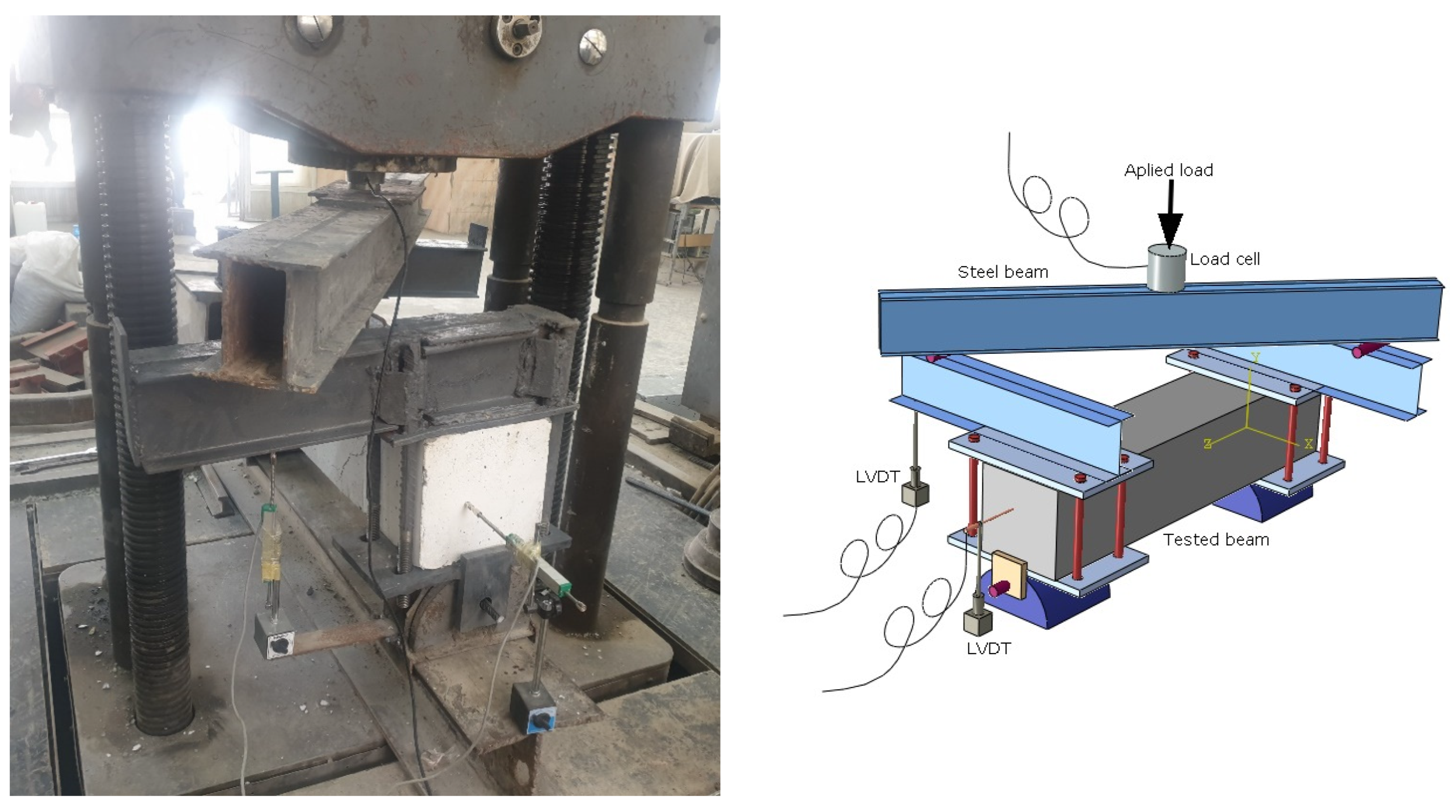
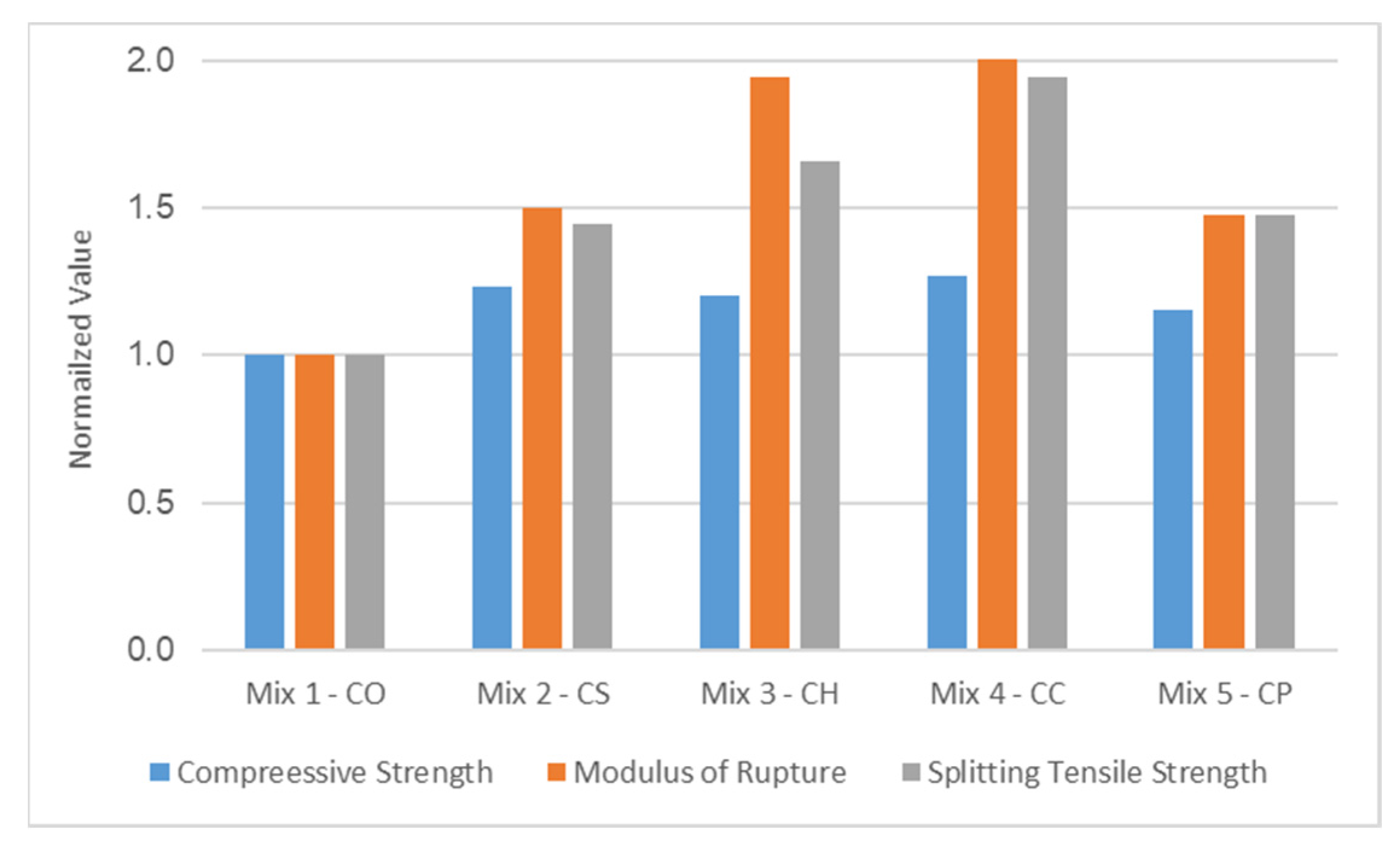

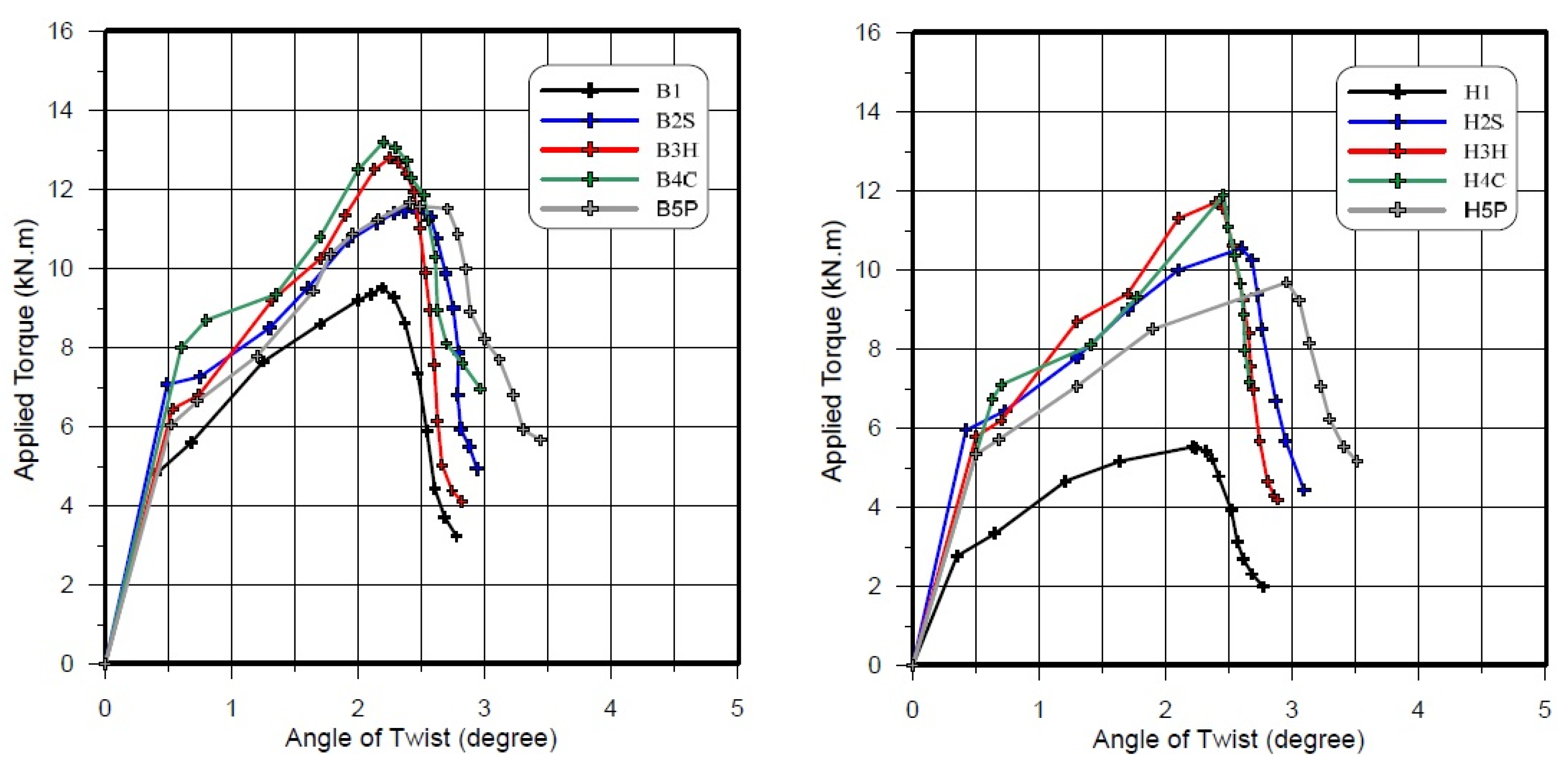

| Standard Test | Test Method | Test Value |
|---|---|---|
| Fineness (m2/kg) | Blaine air permeability | 302 |
| Setting time (minutes) | Initial | 131 |
| Final | 262 | |
| Compressive strength (MPa) | 3 days | 22.7 |
| 7 days | 27.8 |
| Chemical Components of Cement Weight (%) | Main Components of Cement Weight (%) | ||||||||||||
|---|---|---|---|---|---|---|---|---|---|---|---|---|---|
| SiO2 | Al2O3 | Fe2O3 | CaO | MgO | Na2O | K2O | SO3 | Insoluble Residue | LOI | C3S | C2S | C3A | C4AF |
| 20.2 | 5.1 | 3.2 | 62.2 | 1.74 | 0.29 | 0.64 | 1.92 | 0.45 | 1.3 | 50.1 | 24.1 | 6.65 | 10.2 |
| Property | Coarse Aggregate (Gravel) | Fine Aggregate (Sand) |
|---|---|---|
| Bulk specific gravity | 2.42 | 2.63 |
| Apparent specific gravity | 2.40 | 2.72 |
| Dense dry density (kg/m3) | 1632 | 1870 |
| Loose dry density (kg/m3) | 1452 | 1720 |
| Sulphate content (%) | 0.02 | 0.23 |
| Absorption (%) | 0.85 | 1.61 |
| Fiber Type | Shape | Length (mm) | Diameter (mm) | Aspect Ratio | Tensile Strength (MPa) |
|---|---|---|---|---|---|
| Straight steel fiber | Straight | 12 | 0.25 | 50 | 2850 |
| Hooked-end steel fiber | Hooked-end | 30 | 0.5 | 60 | >1000 |
| Corrugated steel fiber | Corrugated | 50 | 0.6 | 83 | >700 |
| Polyolefin fiber | ------ | 60 | 0.84 | 71 | 465 |
| Cement (kg/m3) | Fine Aggregate (kg/m3) | Coarse Aggregate (kg/m3) | Water (kg/m3) | Fiber (kg/m3) | Super Plasticizer PC200 (Liter) | |
|---|---|---|---|---|---|---|
| Steel Fiber | Polyolefin Fiber | |||||
| 396 | 755 | 1125 | 159 | 78 | 9.1 | 4 |
| Beam Specimen | B1 | B2S | B3H | B4C | B5P | H1 | H2S | H3H | H4C | H5P |
|---|---|---|---|---|---|---|---|---|---|---|
| Length (mm) | 1150 | 1150 | 1150 | 1150 | 1150 | 1150 | 1150 | 1150 | 1150 | 1150 |
| Overall depth (mm) | 250 | 250 | 250 | 250 | 250 | 250 | 250 | 250 | 250 | 250 |
| Overall width | 250 | 250 | 250 | 250 | 250 | 250 | 250 | 250 | 250 | 250 |
| Section type | Solid | Solid | Solid | Solid | Solid | Hollow | Hollow | Hollow | Hollow | Hollow |
| Fiber type | ------ | Steel | Steel | Steel | Polyolefin | ----- | Steel | Steel | Steel | Polyolefin |
| Fiber shape | ------ | Straight | Hooked-end | Corrugated | ----- | ------ | Straight | Hooked-end | Corrugated | ---- |
| Longitudinal reinforcement | 4 ϕ12 mm top and bottom | |||||||||
| Transverse reinforcement | Φ8 mm @ 175 mm | |||||||||
| Concrete Mix | Fiber Type | Symbols | Compressive Strength (MPa) | Splitting Tensile Strength (MPa) | Modulus of Rupture (MPa) |
|---|---|---|---|---|---|
| Mix 1 | Control (free of fibers) | CO | 35.7 | 4.18 | 3.21 |
| Mix 2 | Straight steel fiber 12 mm | CS | 44.1 | 6.27 | 4.63 |
| Mix 3 | Hooked-end steel fiber 30 mm | CH | 43 | 8.12 | 5.32 |
| Mix 4 | Corrugated steel fiber 30 mm | CC | 45.4 | 8.95 | 6.24 |
| Mix 5 | Polyolefin fiber 60 mm | CP | 41.3 | 6.18 | 4.73 |
| Item | B1 | B2S | B3H | B4C | B5P | H1 | H2S | H3H | H4C | H5P |
|---|---|---|---|---|---|---|---|---|---|---|
| Cracking torque, TCR (kN.m) | 6.56 | 8.25 | 9.35 | 9.86 | 8.64 | 3.62 | 7.68 | 8.41 | 8.39 | 7.28 |
| Cracking angle of twist, ψcr (deg.) | 0.98 | 1.18 | 1.36 | 1.44 | 1.43 | 0.83 | 1.25 | 1.38 | 1.40 | 1.39 |
| Torsional rigidity (kN.m/rad) | 550.3 | 810.5 | 739.5 | 917.2 | 693.6 | 317.2 | 682.2 | 663.3 | 772.2 | 612.1 |
| Ultimate torque, TCR (kN.m) | 9.50 | 11.5 | 12.8 | 13.2 | 11.7 | 5.5 | 10.6 | 11.7 | 11.9 | 9.7 |
| Ultimate angle of twist, ψu (deg.) | 2.19 | 2.37 | 2.25 | 2.20 | 2.41 | 2.24 | 2.60 | 2.40 | 2.46 | 2.96 |
Publisher’s Note: MDPI stays neutral with regard to jurisdictional claims in published maps and institutional affiliations. |
© 2022 by the authors. Licensee MDPI, Basel, Switzerland. This article is an open access article distributed under the terms and conditions of the Creative Commons Attribution (CC BY) license (https://creativecommons.org/licenses/by/4.0/).
Share and Cite
Abdullah, M.D.; Majeed, F.H.; Saleh, S.M. The Role of Fiber-Type Reinforcement in the Torsional Behavior of Solid and Hollow Reinforced Concrete Beams. Fibers 2022, 10, 80. https://doi.org/10.3390/fib10090080
Abdullah MD, Majeed FH, Saleh SM. The Role of Fiber-Type Reinforcement in the Torsional Behavior of Solid and Hollow Reinforced Concrete Beams. Fibers. 2022; 10(9):80. https://doi.org/10.3390/fib10090080
Chicago/Turabian StyleAbdullah, Mazin Diwan, Fareed Hameed Majeed, and Samoel Mahdi Saleh. 2022. "The Role of Fiber-Type Reinforcement in the Torsional Behavior of Solid and Hollow Reinforced Concrete Beams" Fibers 10, no. 9: 80. https://doi.org/10.3390/fib10090080






